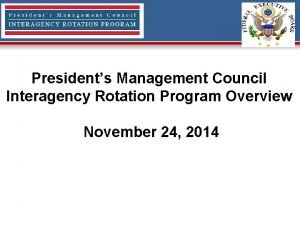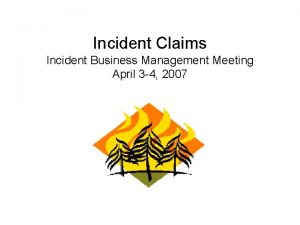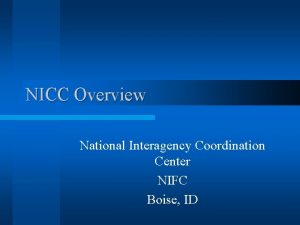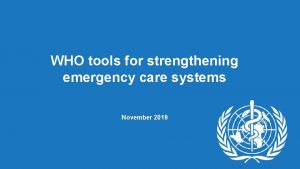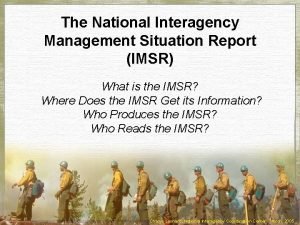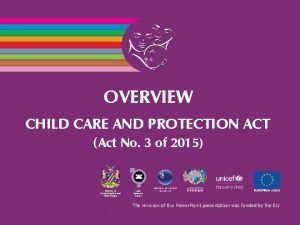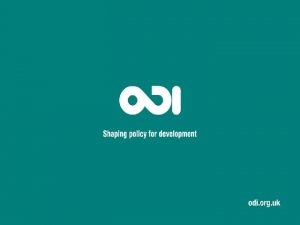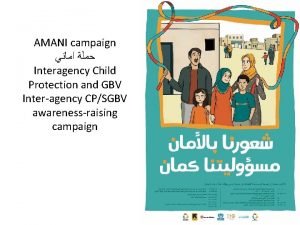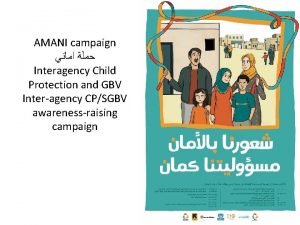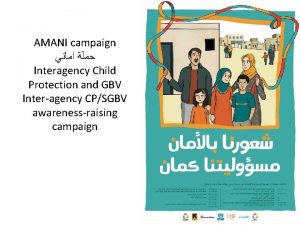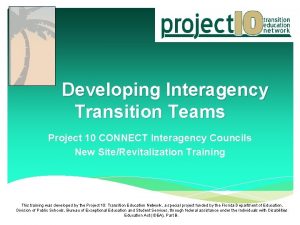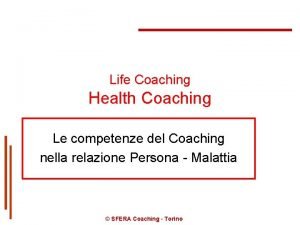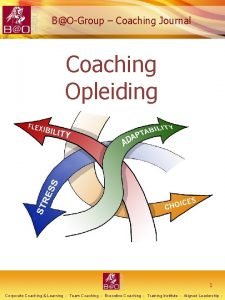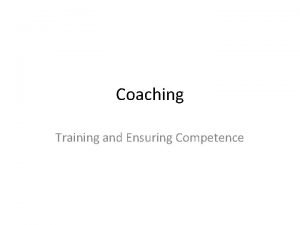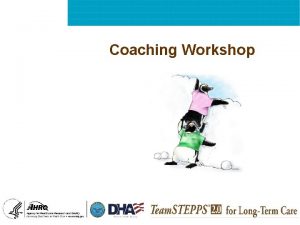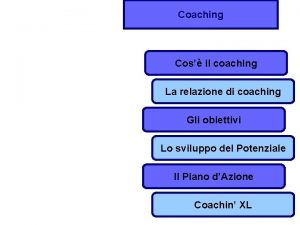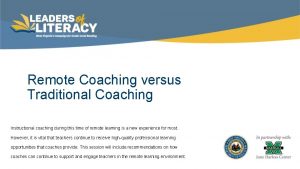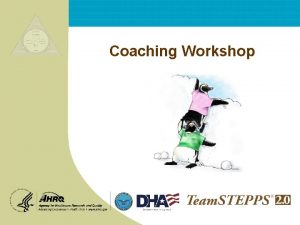Interagency Child Protection Case Management Coaching Project Presented















- Slides: 15

Interagency Child Protection Case Management Coaching Project Presented by IRC & UNHCR Lebanon May 2015

Scoping Exercise: November 2013 Few child protection partners • • Lack of trained and specialized staff and limited capacity building initiatives for child protection case workers • Different standards in child protection case management • Lack of a common understanding on the minimum standards of child protection in emergencies and child protection case management

2014 Coaching Program Scope • Main goal: Increase capacity of case management actors 1. 2. 3. 4. 5. - Training for front-liners on safe identification and referrals Training for Child protection Case Workers and Managers Training for community focal points Monthly Peer to Peer sessions for case workers Development of case management tools within CPi. E WG and Case Management Task force: Practical Guidance; Interagency Referral Form; CP Rapid Assessment; CP Comprehensive Assessment.

2014: Main achievements 1. Harmonization of tools among case management partners; 2. Establishment of a solid network of child protection practitioners: Peer to Peer (over 45 organizations and 200 caseworkers engaged) 3. Child protection mainstreaming across all sectors: training of front liners Mainstreaming child protection in community based protection structures: ROVs, Self Management Committees, Staff in Social Development centers and Community development centers 4. Creation of a synergic link between PSS and CFSs and case management: Peer to Peer 5. Synergic link with general Protection Monitoring 6. Increase number in the identification and referral of CP cases

Outcomes in 2014 • Midterm evaluation- June 2014: • 100% case workers reported their case management skills improved • 90% found peer groups relevant to their daily work, valuable in terms of technical guidance and useful as forum to share practices and challenges

Coaching Program in 2015 • Main goal: To sustainably increase the capacity of humanitarian actors and child protection system § § § Empowering Child Protection actors to provide capacity building to their own staff and partners in order to strengthen child protection systems. TOT’s for Managers and Supervisors of caseworkers and child protection actors. Ongoing follow up for TOT participants through regular support to organize and implement successful training in their respective regions. Sustainability of the Peer to Peer group (expectation of TOT participants to lead sessions) Continuation of training and support to community actors (trainings and Peer to Peer groups for ROV’s)

Ongoing Challenges • More complex child protection issues due to protracted displacement and decrease in humanitarian assistance; • Scattered population and limitation in freedom of movement require case workers to be more and more mobile • Shifting to prioritization of high risk cases due to limited funds • High turnover of staff and stress for caseworkers

Strengthening the Child Protection System in Lebanon Inter-Agency Child Protection meeting Amman - 21 th of May 2015

Partnership & Crosssectorality 2009 – ongoing Linkages/externalities Child Protection System analysis 2011 -2012 Implementation of action reform (program, policy) Planning and prioritization for system building 2013 - ongoing 2012

Partnership CRC concluding Observations for Lebanon - CPD GOL & UNICEF focus – National Social Strategy –– CP national strategy …. Rallying the GOL/MOSA to adopt a system approach in dealing with child protection sector • Child Protection focal points in line Ministries - Champions • An Inter-ministerial National CP Task Force chaired by MOSA established to operationalize the recommendations of the study. • Government: Ministry of social affairs, Ministry of justice, Ministry of Interior, Ministry of Education, Ministry of Public Health • NGO’s • Emergency partners and the child protection in emergency working group and sub-working group for the case management • Academia: Saint Joseph University, Lebanese University, • Individual and institutional experts: Child Frontiers, Independent experts… Funding mobilization: UNICEF core funds, DEVCO 2 (2013)– DEVCO 6 (2015)

Part of UNICEF RO/HQ Monitoring of Results for Equity’ System (Mo. RES) initiatives Report launched in December 2012 after 9 months of mapping and analysis of the functioning of CP mechanisms at the national & local levels. A solid analytical framework was used as well different data collection tools – mixed research team A steering committee of the main CP actors were involved throughout the process

Planning & Prioritization • The bottlenecks run across all Child Protection System Components. However, priorities have been identified for the first implementation phase of action reform, taking into account: v Capacities and resources available (internal and external); v Government own priorities in the sector; v Likelihood of showing measurable progress against removal of identified bottlenecks within the given timeframe (extended to end of December 2013). • The focus of the CP program for 2013 -2014 was on 3 main "products/results/deliverables": v Revised SOPs and tools v IMS of case management of children victims of violence & monitoring of services v Multidisciplinary training modules for CP professionals and non CP professionals

2015 -2016 2014 • The National Standard Operational Procedures (SOP) and tools for protection of children at risk or/victim of violence are developed • Testing of SOP and tools by key agencies • Desk review and integration of comments by the technical team • • • Development of the technical specification of the CPIMS in link with the SOP reviewed by main stakeholders Design and implementation of a competencybased modular training for key front line services providers (Pilot of 60 hours training) Support the development of the guidance note for the emergency focus agencies • • • Operational Procedures (SOP) and related child protection tools and the CPIMS technical specs sent officially to MOSA and HCC for endorsement and printing (May 2015) Launching of the local roll of the SOP on Monday 4 th of May 2015 with MOSA, SDC and relevant CSO’s ( #100) Training of trainers and coaches is on-going (#10) 5 trainings of 30 hours targeting 135 CP professionals to be delivered locally between June and July 2015 in USJ Campuses: Beirut, Zahle, Tripoli and Saida. 1 year of coaching program, every Tuesday & Thursday in SDC for 100 agencies (starting july 2015) Establishment of 13 Case Management Committee in the 8 governorates Development of referral pathways in the 13 localities (duration of the project) Support 1092 boys and girls at risk or victims of violence and harmful practices to access individual case management (duration of the project) Building capacities of 475 professionals from different sectors from government and non-government organizations (September 2015) Capacitation of the Ministry of Social Affairs central division for child protection in following high risk cases and offer timely response and coordination with mandated agencies (MOSA national plan) Procurement and testing of child protection information management system (CPIMS) – June 2015 Final review of the SOP and Tools with integration if emergency related issues (beg 2016)

Linkages with • • • • Revision of the standards agreement with the local NGO/CBO delivering specialized child protection services (bottlenecks identified) Development of alternative care/Specialized services (bottlenecks identified) Review of law 422 (idem) Define roles and mandates of different service providers (e. g. the specific functions of the education and health sectors) Costing of law 422 and budgeting of related services Addressing social norms through targeting campaign and community mobilization against harmful practices Child helpline – Italian fund supported project in Mo. SA Child Protection policy Guidelines for nurseries GBV SOP – sector leadership Parental skills training MRM Etc. .

SOP ARE NOT: X NOT addressing the availability of specialized and non specialized services including alternative care ü Through the case management procedures, it ensures quality follow up and monitoring delivery of services within the existing resources X NOT changing the law 422 ü It will contribute to the strengthen the CP component of the law 422 in the amendment process through the integration of the processes and procedures developed X NOT emergency focused ü It has all the elements that should work in emergency contexts X NOT addressing the discriminatory practices and/or the performance of professionals/government and NGO staff ü It will raise the level of accountability and transparency of the case managers and has determined clear roles and responsibilities
 Child protection case management tools
Child protection case management tools President's management council interagency rotation program
President's management council interagency rotation program Interagency incident business management handbook
Interagency incident business management handbook Best case worst case average case
Best case worst case average case Interagency institute for federal health care executives
Interagency institute for federal health care executives National interagency coordination center
National interagency coordination center Interagency integrated triage tool
Interagency integrated triage tool National fire situation report
National fire situation report Traditional project management vs modern project management
Traditional project management vs modern project management Safeguarding and child protection the essentials
Safeguarding and child protection the essentials Courage child protection
Courage child protection Types of child protection
Types of child protection Children's rights and responsibilities posters
Children's rights and responsibilities posters Types of child protection
Types of child protection Types of child protection
Types of child protection Child protection and toy safety act
Child protection and toy safety act

